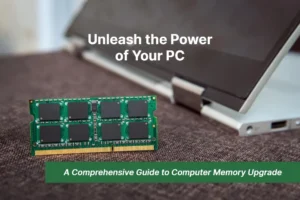To identify compatible RAM for your laptop, consult the manufacturer’s website or the laptop’s manual. Check the maximum capacity and type of RAM your laptop can support, then purchase accordingly.
Upgrading your laptop’s RAM can significantly improve its performance, so it’s essential to choose the right one. Having the correct RAM for your laptop is crucial for its overall performance and smooth functioning. But with various options available in the market, it can be challenging to determine which RAM is compatible.
In this guide, we’ll discuss how to find the right RAM for your laptop, factors to consider when purchasing RAM, and the benefits of upgrading your laptop’s RAM. By the end, you’ll have all the information you need to confidently upgrade your laptop’s RAM.
Understanding Ram And Its Importance
RAM is a vital component of your laptop, contributing to its performance and speed. It’s essential to know the exact type and specifications compatible with your laptop when considering an upgrade. Ensure compatibility by checking your laptop’s model and motherboard specifications before purchasing RAM for an optimal performance boost.
Understanding RAM and Its Importance What is RAM? RAM, or Random Access Memory, is a crucial component of a laptop’s architecture. It serves as the temporary workspace for data and instructions that the CPU needs to access quickly. Unlike storage devices, such as hard drives or SSDs, RAM is volatile, meaning it only retains data while the computer is powered on. When the laptop is turned off, the data stored in RAM is lost. The importance of RAM in laptop performance The Importance of RAM in Laptop Performance RAM plays a vital role in the overall performance of a laptop. Here’s why it’s essential: 1. Multitasking Capability: With sufficient RAM, a laptop can handle multiple tasks simultaneously without slowing down. This is especially important for users who frequently switch between applications or work with large files. 2. Speed and Responsiveness: More RAM allows data to be accessed and processed quickly, leading to a more responsive system and reduced loading times for applications and files. 3. Application Performance: RAM directly impacts the performance of applications. Software, especially resource-intensive programs like video editors and design software, benefit from ample RAM for smooth operation. 4. Future-Proofing: As software and operating systems become more demanding, having ample RAM ensures that the laptop can meet the requirements of newer applications and updates without becoming obsolete. 5. Gaming Experience: For avid gamers, sufficient RAM is crucial for running graphically demanding games without experiencing lag or stuttering. In conclusion, understanding the role of RAM and its significance in laptop performance is essential for making informed decisions when considering upgrading or purchasing a new device. Keep these key points in mind to ensure that your laptop has the necessary RAM to meet your computing needs.
Credit: www.avg.com
How To Determine Your Laptop’s Ram Compatibility
The compatibility of RAM with your laptop is an essential factor to consider when upgrading or replacing your laptop’s memory. To determine the compatible RAM for your laptop, you need to check your laptop’s specifications and understand the different RAM types and speeds available in the market. This blog post will guide you through the process of determining your laptop’s RAM compatibility using hassle-free methods.Checking Your Laptop’s Specifications
One of the simplest ways to find out the RAM compatibility is by checking your laptop’s specifications. Follow these steps to do so:- Start by locating your laptop’s model name or number. This information can usually be found on the sticker located on the bottom of your laptop or in the system information settings.
- Once you have determined your laptop’s model name or number, visit the manufacturer’s website or perform a quick internet search to find the official specifications.
- Look for the maximum amount of RAM supported by your laptop. This information is typically listed under the “Memory” or “RAM” section of the specifications.
- Pay attention to the specific type and speed of RAM mentioned in the specifications. This information will help you ensure compatibility when purchasing new RAM modules.
Understanding Different Ram Types And Speeds
RAM comes in various types and speeds, and it’s crucial to understand the differences to ensure compatibility with your laptop. Here are the key points to consider:Type of RAM:
- DDR: DDR stands for Double Data Rate and is one of the most commonly used types of RAM. It has different generations, such as DDR3 and DDR4. Ensure you choose the generation supported by your laptop.
- SODIMM: SODIMM, short for Small Outline Dual In-line Memory Module, is a smaller form factor used for laptop RAM. Make sure to select SODIMM modules, as they are designed specifically for laptops.
RAM Speed:
When it comes to RAM speed, it’s essential to select modules that match the supported speed of your laptop. The RAM speed is measured in MHz and is indicated in the laptop’s specifications. Ensure you:- Choose RAM modules with the same speed or higher as specified by your laptop.
- Avoid purchasing RAM with a lower speed than what is supported, as it may limit the overall performance of your laptop.
Upgrading Your Laptop’s Ram
Is your laptop feeling sluggish and slow? It might be time to consider upgrading your laptop’s RAM. Random Access Memory, or RAM, is a crucial component in your laptop that affects its speed and performance. By upgrading your laptop’s RAM, you can give it a much-needed boost and enjoy smoother multitasking, faster program loading times, and improved overall performance.
Choosing The Right Ram For Your Laptop
Step 1: Determine the type of RAM your laptop requires. Different laptops require different types of RAM, such as DDR2, DDR3, or DDR4. To find out which type your laptop supports, you can refer to the manufacturer’s website or user manual.
Step 2: Check the maximum RAM capacity of your laptop. Each laptop has a maximum RAM capacity it can support. Exceeding this limit may cause compatibility issues or result in the system not recognizing the additional RAM. To find the maximum RAM capacity of your laptop, again, you can refer to the manufacturer’s website or user manual.
Step 3: Determine the speed of the RAM you need. RAM speed is measured in megahertz (MHz) and affects the rate at which data can be read from and written to the RAM. Higher RAM speeds generally result in better performance. However, it’s important to check your laptop’s specifications to ensure compatibility.
Step 4: Consider the amount of RAM you need. The amount of RAM you choose depends on your usage requirements. If you’re a casual user, 4GB or 8GB of RAM should be sufficient. However, if you frequently run memory-intensive applications or multitask heavily, opting for 16GB or more may be beneficial.
Step-by-step Guide To Installing Ram
- Step 1: Before you begin, make sure to turn off your laptop and unplug it from the power source. Safety first!
- Step 2: Locate the RAM slots on your laptop. These are usually found on the underside of the device.
- Step 3: Gently remove the screws or clips securing the RAM compartment cover. Set the cover aside in a safe place.
- Step 4: Take your new RAM module(s) out of their packaging, ensuring you touch only the edges to avoid any damage from static electricity.
- Step 5: Insert the RAM module(s) into the empty slots, aligning the notches on the module with the ridges in the slots.
- Step 6: Apply gentle pressure to each side of the module until it clicks into place.
- Step 7: Replace the RAM compartment cover and secure it with the screws or clips.
- Step 8: Plug your laptop back in and power it on. Your laptop should recognize the new RAM automatically.
- Step 9: To ensure that the new RAM is functioning correctly, you can check the system information or use a third-party software to verify the installed memory capacity.
By following these simple steps, you can upgrade your laptop’s RAM and experience a noticeable improvement in performance. Say goodbye to sluggishness and hello to smooth multitasking!

Credit: www.pcworld.com
Optimizing Ram Performance
Looking to optimize the performance of your laptop’s RAM? Find compatible RAM for your laptop to boost its speed and efficiency. Upgrading your laptop’s memory can lead to enhanced multitasking and overall improved performance.
Managing Background Processes
One key aspect of optimizing RAM performance is efficiently managing background processes. These are the programs and applications running in the background while you use your laptop. Background processes consume memory, which can slow down your system if too many are running at the same time.
To ensure optimal RAM performance, it’s essential to identify and close unnecessary background processes. Follow these steps:
- Open the Task Manager by pressing Ctrl + Shift + Esc.
- Navigate to the “Processes” tab.
- Sort the processes by “Memory (Private Working Set)” to identify the ones consuming the most RAM.
- Right-click on the process and select “End Task” to close it.
By selectively closing unnecessary background processes, you can free up valuable RAM for your laptop to utilize for other tasks, improving overall performance.
Tips For Maximizing Ram Efficiency
When it comes to maximizing your laptop’s RAM efficiency, there are a few tips and tricks you can follow:
- Consider upgrading the RAM: If your laptop allows for RAM upgrades, increasing its capacity can significantly improve performance.
- Close unused applications: Running multiple applications simultaneously can strain your RAM. Close any unused programs to free up memory.
- Use a lightweight operating system: If your laptop struggles with RAM-intensive tasks, consider switching to a lightweight operating system that requires fewer resources.
- Disable unnecessary startup programs: Some programs automatically start when you boot up your laptop, utilizing precious RAM. Disable these programs to conserve memory.
- Avoid running too many browser tabs: Each open tab in your web browser consumes memory. Close tabs that you’re not actively using to improve RAM efficiency.
- Regularly clean up your hard drive: A cluttered hard drive can slow down your system and impact RAM performance. Delete unused files and clear temporary files to optimize your laptop’s performance.
By implementing these tips and optimizing your RAM usage, you can ensure that your laptop performs at its best, providing a smooth and efficient computing experience.
Common Ram Compatibility Issues
Discovering RAM compatibility issues with your laptop? Learn what RAM is compatible with your laptop and avoid the common issues that may arise. Ensure smooth performance and optimize your laptop’s efficiency by finding the right RAM for your device.
Identifying And Troubleshooting Compatibility Issues
When upgrading the RAM of your laptop, it is crucial to identify and troubleshoot any compatibility issues that may arise. These issues can prevent your new RAM from functioning optimally, causing performance problems and system instability. By understanding and resolving these common compatibility issues, you can ensure a successful RAM upgrade for your laptop.
Incorrect Ram Type
One of the most common compatibility issues is using an incorrect RAM type for your laptop. Not all RAM modules are compatible with every laptop model, so it is essential to identify the specific RAM type required. Refer to your laptop’s user manual or visit the manufacturer’s website to find information on the compatible RAM modules. Installing the wrong RAM type can lead to booting failures or even permanent damage to your laptop.
Incompatible Ram Speed
RAM modules come in different speed ratings, indicated in megahertz (MHz). Using incompatible RAM speeds can cause system instability and potential data corruption. To determine the compatible RAM speed for your laptop, check your laptop’s specifications or consult the manufacturer’s website. It is advisable to choose RAM modules with the same or lower speed rating than specified to ensure seamless compatibility.
Insufficient Ram Capacity
Another common issue is not having sufficient RAM capacity to support your laptop’s requirements. Insufficient RAM can lead to sluggish performance, slow multitasking, and frequent system crashes. To determine the adequate RAM capacity, consider your laptop’s processor and the tasks you often perform. Gaming or resource-intensive applications may require more RAM compared to basic web browsing. Upgrade your laptop with sufficient RAM capacity to prevent performance bottlenecks and ensure smooth operation.
Incorrect Ram Voltage
RAM modules require a specific voltage to function properly. Using RAM with a voltage rating that does not match your laptop’s requirements can result in compatibility issues. Check your laptop’s specifications or user manual to identify the recommended RAM voltage. Installing RAM with the incorrect voltage can cause the laptop to fail to boot or even damage the RAM modules and other components.
Seeking Professional Help
If you are unsure about identifying or troubleshooting RAM compatibility issues, seeking professional help is recommended. Certified technicians experienced in laptop hardware can assist you in selecting the compatible RAM for your laptop model and ensure a successful upgrade. They can also troubleshoot any compatibility issues and provide guidance on resolving them effectively. Consulting an expert can save time, effort, and prevent potential damage to your laptop.
Remember, addressing common RAM compatibility issues is crucial to ensure a smooth and successful upgrade for your laptop. By identifying and troubleshooting these issues, you can optimize your laptop’s performance and enjoy the benefits of increased RAM capacity.

Credit: www.avg.com
Frequently Asked Questions On What Ram Is Compatible With My Laptop
What Factors Should I Consider When Choosing A Compatible Ram For My Laptop?
When choosing a compatible RAM for your laptop, you should consider factors such as your laptop’s motherboard specifications, maximum RAM capacity, type and speed of RAM supported, and the number of RAM slots available.
Can I Upgrade The Ram On My Laptop?
Yes, in most cases, you can upgrade the RAM on your laptop. However, it is important to check your laptop’s specifications and ensure that it has replaceable or upgradable RAM modules.
How Much Ram Do I Need For My Laptop?
The amount of RAM you need for your laptop depends on your specific requirements and intended usage. For basic tasks like web browsing and word processing, 8GB of RAM is often sufficient. For more demanding applications like graphic design or gaming, 16GB or more may be recommended.
Is It Possible To Mix Different Brands Of Ram In My Laptop?
While it is technically possible to mix different brands of RAM in your laptop, it is generally not recommended. Mixing different brands can potentially cause compatibility issues, resulting in system instability or performance degradation. It is best to use RAM modules from the same manufacturer and with identical specifications.
Conclusion
To summarize, finding the right RAM for your laptop is a crucial step in maximizing its performance. By considering factors like compatibility, capacity, and speed, you can make an informed decision. Remember to consult your laptop’s manual or manufacturer’s website for specific requirements.
Upgrading your RAM can greatly enhance your laptop’s speed and overall efficiency, ensuring a smooth and seamless user experience. Take your time, do your research, and enjoy the benefits of a well-equipped laptop.


